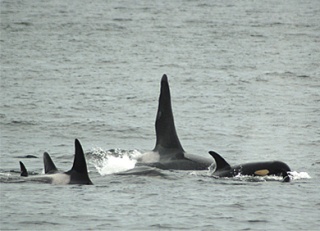Decibel levels of sonar pings recorded off the west side of San Juan Island April 7-8 may have been the same level as sonar pings implicated in the deaths of several beaked whales in the Bahamas in October 2003.
That’s according to Dr. Val Veirs, president of The Whale Museum board and professor emeritus of physics at Colorado College. Hydrophones operated by The Whale Museum and Beam Reach Marine Science and Sustainability School started recording sonar pings and what sounded like garbled human speech beginning at 7 p.m. on April 7. The pings and sounds continued into the early morning.
The sounds from these hydrophones stream live via the Internet on www.orcasound.net. Samples of the recorded sounds are archived there. CLICK HERE.
Examination of the recorded sounds shows that the sound levels at the southern location, Lime Kiln Lighthouse, were usually higher than at the more northern location off the west side of San Juan Island, Veirs said. It is likely that the sound source was generally south of San Juan Island.
“The received levels of the signals at Lime Kiln Lighthouse were about the most intense sounds that the hydrophones there have recorded in the past several years of continuous operation,” he said. “The highest received levels came from sonar pings. The highest received levels were approximately 140 dB re 1 microPascal. This is approximately the same as the most intense sonar signals recorded in May 2003 when the (USS) Shoup transited the waters of Haro Strait. The base frequency of the sonar pings was about 3 kHz, which suggests that the sonar is the Navy’s mid-frequency sonar which was implicated in the death of multiple beaked whales in the Bahamas October 2003.
The sonar pings Tuesday and Wednesday are believed to have come from the USS San Francisco, a submarine reportedly operating in the Strait of Juan de Fuca at the time.
“The garbled voices we heard were used for communication between the submarine and a surface tender,” Veirs said. “We estimate that the distance between our hydrophone at Lime Kiln Lighthouse and the submarine was in the neighborhood of 10 nautical miles and for our hydrophones to pick up the strong signals that they did, the submarine was emitting sound with source level in the range 175 dB to 225 dB re 1 microPasca1.”
Veirs said the sounds were heard for many miles in a variety of underwater locations — from the east at Whidbey Island to the north of San Juan Island and out toward the ocean in the Strait of Juan de Fuca.
The Whale Museum has not received reports of stranded or injured marine animals. If you see an injured or stranded marine mammal, contact the San Juan County Marine Mammal Stranding Network, (800) 562-8832).
EARLIER STORY: Jeanne Hyde reports the sonar “actually hurt my ears as I heard it over my computer speaker … I can’t imagine what it was like to any marine mammal that may have been near.” STORY




